A team of scientists working with the Rice University and with Nano3D Biosciences recently made it public news that they had managed to piece together three-dimensional artificial – and yet quite realistic – lung tissue with the help of magnetic levitation.
As explained on the official website for the Rice University, the researchers' decision to levitate cells with the help of magnetism and gradually force the cells' hand into forming artificial lung tissue stemmed from their desire to create tissues which are almost identical to those naturally occurring inside an individual's organism.
Up until now, such artificial tissues were grown with the help of petri dishes. However, as PopSci explains, flat-cultured cells encounter difficulties in behaving similarly to cells obtained by means of 3-D cultures, which is why the latter are preferable.
Commenting on this experiment, Tom Killian, presently employed as Professor and Department Chair of Physics and Astronomy at the Rice University argued as follows:
“One of the unique things about the magnetic levitation technology is that it allows us to move cells around and arrange them the way that we want for a particular types of tissue.”
“This is the first time anyone has arranged these four cell types in the same way that they are found in lung tissue,” he went on to add.
According to the same source, the science talk surrounding the researchers' using magnetic levitation in order to grow 3-D artificial lung tissue is pretty straightforward and fairly easy to comprehend.
Thus, all one needs to do is insert inert, magnetic nanoparticles in the cells, and later on use magnets to manipulate them.
Despite the fact that it all sounds very simple on paper, the researchers wished to emphasize that things are a tad more complicated when it comes to applying all this theory.
“Growing realistic lung tissues in vitro is a particular challenge. There are a number of technical obstacles, and scientific funding agencies have placed a particular emphasis on lung tissue because there’s a large potential payoff in terms of reducing costs for pharmaceutical and toxicological testing,” stated Jane Grande-Allen, a professor of Bioengineering at the Rice University.

 14 DAY TRIAL //
14 DAY TRIAL //